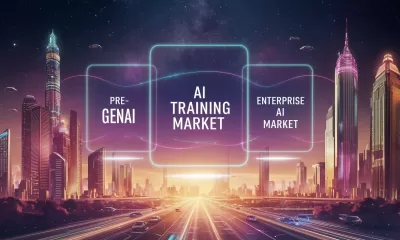Life
How Will AI Skills Impact Your Career and Salary in 2025?
Discover the top 10 AI skills that can help you earn up to 47% more, according to Coursera and AWS data. Learn why employers are demanding AI-savvy professionals and how you can start building these in-demand skills today.
Published
3 months agoon
By
AIinAsia
L;DR – What You Need to Know in 30 Seconds
- AI Course Demand Is Soaring: There’s been an 866% year-on-year increase in AI skill interest CourseraCourseraCoursera.
- Employers Are Eager: 3 out of 4 companies use GenAI and 62% want employees clued up on AI Coursera.
- Big Salary Boosts: AI-savvy professionals can earn up to 47% more, with the highest gains in marketing, finance, and business ops Indeed, AWS.
- Top 10 Skills: Focus on GenAI, neural networks, computer vision, and ML operations to stay ahead Coursera.
AI Skills are the New Currency for Salary Negotiations in 2025
If you’ve been paying attention to the tech world lately, you’ll know that generative AI (GenAI) is causing quite the stir. In fact, it’s being hailed as the “fastest growing job skill of our time,” and it’s backed by some incredible data.
According to Coursera’s latest Job Skills Report 2025 (Coursera), there’s been an 866% year-on-year surge in demand for learning AI—yes, you read that right, eight hundred and sixty-six percent! That uptick isn’t just a meaningless statistic either, as employers are getting on board faster than you can say “machine learning.”
So if you’re keen on taking your career to the next level—or simply avoiding obsolescence—the question is: Which AI skills should you be investing your precious time in? Stick with me, and I’ll walk you through the top 10 must-learn AI skills, how they can boost your salary by up to 47%, and how you can start learning them (often for free or at a significantly discounted rate).
Why AI Skills Are Worth Your Time
Here’s the skinny on why AI is all the rage. Over the past two years, Coursera found a 1,100% surge in AI course demand from employed professionals, a 500% rise among students, and a whopping 1,600% jump for job-seekers. And that’s not even the whole story:
- Three in four employers are already using GenAI in some shape or form, and 62% expect employees to have a basic familiarity with AI tools.
- 22% of recruiters have even updated their job descriptions to include AI prerequisites, and you can bet that number will grow by the end of the year.
- Another poll, conducted by AWS last year, revealed that 92% of businesses plan to adopt AI-powered solutions by 2028, while 73% consider hiring AI-savvy talent a top priority AWSAWSAWS. The problem? 75% of them claim they “can’t find the talent they need”.
Clearly, the workforce is playing a frantic game of catch-up with the skyrocketing AI demands. And if you’re thinking about what’s in it for you personally, Indeed says AI skills can pad your wallet to the tune of 47% more in salary compared to non-AI roles. Specifically, the biggest pay bumps can be found in:
- Sales and marketing: 43% higher
- Finance: 42%
- Business operations: 41%
- Legal, regulatory, compliance: 37%
- Human resources: 35%
All that to say, the numbers don’t lie—AI isn’t just a fancy buzzword. “There’s an immediate need for professionals to pursue these skills to improve their job readiness,” the Coursera report stated.
AI will impact nearly every job role, necessitating upskilling across all industries… Therefore, understanding AI fluency is essential for all employees and students, regardless of their role, age, or background.
10 Fastest Growing AI Skills to Learn in 2025
If you’re ready to dive in, Coursera analysed over 1,000 skills across five million learners globally to identify the top 10 AI skills professionals should prioritise. Here’s the list in all its glory:
- Generative AI – Use AI to generate text, images, and beyond.
- Artificial Neural Networks – Develop computer systems that mimic the learning processes of the human brain.
- Computer Vision – Teach computers to “see” and understand images or videos.
- PyTorch – A powerful machine learning library for building complex AI applications.
- Machine Learning – Train computers to learn from data (the backbone of all AI).
- Applied Machine Learning – Use machine learning techniques to solve real-world problems.
- Deep Learning – Develop sophisticated AI models for highly complex tasks.
- Supervised Learning – Train AI with labelled data, guiding the model to make accurate predictions.
- Reinforcement Learning – Train AI via trial and error, rewarding correct actions and penalising incorrect ones.
- MLOps (Machine Learning Operations) – Effectively manage, deploy, and monitor machine learning models in production.
Feel free to tackle these skills one by one or take a pick-and-mix approach. The point is, each skill addresses a distinct facet of AI—whether it’s purely theoretical or intensely practical.
How to Get Started: Learning AI Skills Online
Let’s be honest: not everyone has the time or inclination to enrol in a four-year university programme. Lucky for us, it’s the 21st century, and the internet is brimming with resources to help you learn these skills without quitting your day job. Here are a few popular options:
- IBM SkillsBuild: This platform offers 100% free courses. Yes, you heard that right—free.
- Coursera: Known for its many professional certificates and courses, Coursera has a mix of free offerings and paid programmes. You can also apply for financial aid to potentially access courses at no cost.
- Codecademy: If you prefer a subscription model, Codecademy’s monthly or yearly plans give you access to AI, Python, and machine learning courses (including PyTorch).
Tailoring Your Learning Path
Bear in mind, not all 10 AI skills may be relevant to your current role or future aspirations. Maybe you’re in marketing, so learning Generative AI for content creation could be your top priority. Or perhaps you’re a data analyst, making advanced skills in deep learning or reinforcement learning more crucial. Regardless, continuous learning sets you apart in a job market that’s increasingly demanding AI expertise.
The Power of AI Skills for Your Career
Here’s the thing: your value in the job market really boils down to two aspects—your skill set and your willingness to keep it fresh and relevant. With AI weaving its way into almost every industry, it’s a smart move to upskill now rather than wait till your role is rendered redundant. Plus, the compensation perks are substantial.
Even if you’re not aiming to become a full-blown AI engineer, having a moderate familiarity with AI tools can set you apart during performance reviews or job interviews. You might find yourself at the forefront of new AI initiatives in your organisation, possibly scoring that promotion or raise sooner than you’d think.
AI is transforming business models globally, creating an urgent need for employees who can leverage these tools across diverse job functions.
Whether you’re a project manager, financial analyst, HR professional, or content creator, there’s likely an AI tool that can make your life easier—and your output more valuable.
How AI Skills Can Future-Proof You
Let’s face it, business transformations happen at breakneck speed these days. AI, in particular, is no longer a niche skill—it’s steadily becoming a baseline expectation for a wide range of roles. Recruiters are scouring CVs for AI buzzwords, and if you have them, you’re already leaps and bounds ahead of your competition.
But it’s not just about ticking the box for employers. AI literacy also makes you more adaptable. If your company decides to pivot to new tech, you won’t be left floundering. Instead, you’ll be at the heart of the action, driving change, and potentially shaping the future of your organisation.
Consider how AI intersects with everyday tasks. In HR, data-driven recruitment tools are changing the way we screen candidates. In finance, predictive modelling is helping analysts forecast market trends more accurately. In marketing, AI-driven campaigns are now standard fare rather than futuristic pipe dreams. And let’s not forget how generative AI can whip up blog posts, social media updates, and ad copy in the blink of an eye—freeing up time for more strategic thinking.
Next Steps: Making AI Your Competitive Advantage
So, what are you waiting for? The resources are there, and the world is rapidly moving towards an AI-driven horizon. Whether you fancy yourself a future machine learning guru or just want to keep pace with the times, picking up even a couple of these AI skills will pay off in spades. Here’s the bottom line:
- Identify Your AI Use Cases – Pick the skill that aligns best with your day-to-day responsibilities.
- Select Your Platform – Check out IBM SkillsBuild, Coursera, or Codecademy for online course options.
- Stay Consistent – Allocate a set amount of time each week to practice or study.
- Document Your Progress – Certifications and portfolio projects can make your new skills shine on your CV.
And if you’re still on the fence, remember that hiring managers and senior leadership are actively looking for people who can help them integrate AI into their business strategies. So why not be that person?
Final Thoughts
Generative AI has arrived in a big way, and the job market is scrambling to keep pace. Whether you’re dreaming of a new gig, eyeing a promotion, or just looking to future-proof your career, grabbing hold of AI skills could be the smartest move you make this year. The demand is high, the salaries are higher, and the barrier to entry has never been lower.
So here’s my question to you: Are you ready to seize the AI gold rush, or will you let this once-in-a-generation opportunity pass you by?
Subscribe to keep up-to-date with the latest AI happenings in Asia.
You may also like:
- Coursera Launches Revolutionary Gen AI Skills Training for Teams
- Bridging the AI Skills Gap: Why Employers Must Step Up
- 5 Prompts to Ignite Your Job Search With AI
Author
Discover more from AIinASIA
Subscribe to get the latest posts sent to your email.
You may like
-


Adrian’s Arena: Will AI Get You Fired? 9 Mistakes That Could Cost You Everything
-


The Three AI Markets Shaping Asia’s Future
-


Adobe Jumps into AI Video: Exploring Firefly’s New Video Generator
-


How Singtel Used AI to Bring Generations Together for Singapore’s SG60
-


Unearthly Tech? AI’s Bizarre Chip Design Leaves Experts Flummoxed
-


New York Times Encourages Staff to Use AI for Headlines and Summaries
Life
Adrian’s Arena: Will AI Get You Fired? 9 Mistakes That Could Cost You Everything
Will AI get you fired? Discover 9 career-killing AI mistakes professionals make—and how to avoid them.
Published
2 weeks agoon
May 15, 2025
TL;DR — What You Need to Know:
- Common AI mistakes that cost jobs can happen — fast
- Most are fixable if you know what to watch for.
- Avoid these pitfalls and make AI your career superpower.
Don’t blame the robot.
If you’re careless with AI, it’s not just your project that tanks — your career could be next.
Across Asia and beyond, professionals are rushing to implement artificial intelligence into workflows — automating reports, streamlining support, crunching data. And yes, done right, it’s powerful. But here’s what no one wants to admit: most people are doing it wrong.
I’m not talking about missing a few prompts or failing to generate that killer deck in time. I’m talking about the career-limiting, confidence-killing, team-splintering mistakes that quietly build up and explode just when it matters most. If you’re not paying attention, AI won’t just replace your role — it’ll ruin your reputation on the way out.
Here are 9 of the most common, most damaging AI blunders happening in businesses today — and how you can avoid making them.
1. You can’t fix bad data with good algorithms.
Let’s start with the basics. If your AI tool is churning out junk insights, odds are your data was junk to begin with. Dirty data isn’t just inefficient — it’s dangerous. It leads to flawed decisions, mis-targeted customers, and misinformed strategies. And when the campaign tanks or the budget overshoots, guess who gets blamed?
The solution? Treat your data with the same respect you’d give your P&L. Clean it, vet it, monitor it like a hawk. AI isn’t magic. It’s maths — and maths hates mess.
2. Don’t just plug in AI and hope for the best.
Too many teams dive into AI without asking a simple question: what problem are we trying to solve? Without clear goals, AI becomes a time-sink — a parade of dashboards and models that look clever but achieve nothing.
Worse, when senior stakeholders ask for results and all you have is a pretty interface with no impact, that’s when credibility takes a hit.
AI should never be a side project. Define its purpose. Anchor it to business outcomes. Or don’t bother.
3. Ethics aren’t optional — they’re existential.
You don’t need to be a philosopher to understand this one. If your AI causes harm — whether that’s through bias, privacy breaches, or tone-deaf outputs — the consequences won’t just be technical. They’ll be personal.
Companies can weather a glitch. What they can’t recover from is public outrage, legal fines, or internal backlash. And you, as the person who “owned” the AI, might be the one left holding the bag.
Bake in ethical reviews. Vet your training data. Put in safeguards. It’s not overkill — it’s job insurance.
4. Implementation without commitment is just theatre.
I’ve seen it more than once: companies announce a bold AI strategy, roll out a tool, and then… nothing. No training. No process change. No follow-through. That’s not innovation. That’s box-ticking.
If you half-arse AI, it won’t just fail — it’ll visibly fail. Your colleagues will notice. Your boss will ask questions. And next time, they might not trust your judgement.
AI needs resourcing, support, and leadership. Otherwise, skip it.
5. You can’t manage what you can’t explain.
Ever been in a meeting where someone says, “Well, that’s just what the model told us”? That’s a red flag — and a fast track to blame when things go wrong.
So-called “black box” models are risky, especially in regulated industries or customer-facing roles. If you can’t explain how your AI reached a decision, don’t expect others to trust it — or you.
Use interpretable models where possible. And if you must go complex, document it like your job depends on it (because it might).
6. Face the bias before it becomes your headline.
Facial recognition failing on darker skin tones. Recruitment tools favouring men. Chatbots going rogue with offensive content. These aren’t just anecdotes — they’re avoidable, career-ending screw-ups rooted in biased data.
It’s not enough to build something clever. You have to build it responsibly. Test for bias.
Diversify your datasets. Monitor performance. Don’t let your project become the next PR disaster.
7. Training isn’t optional — it’s survival.
If your team doesn’t understand the tool you’ve introduced, you’re not innovating — you’re endangering operations. AI can amplify productivity or chaos, depending entirely on who’s driving.
Upskilling is non-negotiable. Whether it’s hiring external expertise or running internal workshops, make sure your people know how to work with the machine — not around it.
8. Long-term vision beats short-term wow.
Sure, the first week of AI adoption might look good. Automate a few slides, speed up a report — you’re a hero.
But what happens three months down the line, when the tool breaks, the data shifts, or the model needs recalibration?
AI isn’t set-and-forget. Plan for evolution. Plan for maintenance. Otherwise, short-term wins can turn into long-term liabilities.
9. When everything’s urgent, documentation feels optional.
Until someone asks, “Who changed the model?” or “Why did this customer get flagged?” and you have no answers.
In AI, documentation isn’t admin — it’s accountability.
Keep logs, version notes, data flow charts. Because sooner or later, someone will ask, and “I’m not sure” won’t cut it.
Final Thoughts: AI doesn’t cost jobs. People misusing AI do.
Most AI mistakes aren’t made by the machines — they’re made by humans cutting corners, skipping checks, and hoping for the best. And the consequences? Lost credibility. Lost budgets. Lost roles.
But it doesn’t have to be that way.
Used wisely, AI becomes your competitive edge. A signal to leadership that you’re forward-thinking, capable, and ready for the future. Just don’t stumble on the same mistakes that are currently tripping up everyone else.
So the real question is: are you using AI… or is it quietly using you?
You may also like:
- Bridging the AI Skills Gap: Why Employers Must Step Up
- From Ethics to Arms: Google Lifts Its AI Ban on Weapons and Surveillance
- Or try the free version of Google Gemini by tapping here.
Author
-
Adrian is an AI, marketing, and technology strategist based in Asia, with over 25 years of experience in the region. Originally from the UK, he has worked with some of the world’s largest tech companies and successfully built and sold several tech businesses. Currently, Adrian leads commercial strategy and negotiations at one of ASEAN’s largest AI companies. Driven by a passion to empower startups and small businesses, he dedicates his spare time to helping them boost performance and efficiency by embracing AI tools. His expertise spans growth and strategy, sales and marketing, go-to-market strategy, AI integration, startup mentoring, and investments. View all posts
Discover more from AIinASIA
Subscribe to get the latest posts sent to your email.
Life
FAKE FACES, REAL CONSEQUENCES: Should NZ Ban AI in Political Ads?
New Zealand has no laws preventing the use of deepfakes or AI-generated content in political campaigns. As the 2025 elections approach, is it time for urgent reform?
Published
2 weeks agoon
May 14, 2025By
AIinAsia
TL;DR — What You Need to Know
- New Zealand politician campaigns are already dabbling with AI-generated content — but without clear rules or disclosures.
- Deepfakes and synthetic images of ethnic minorities risk fuelling cultural offence and voter distrust.
- Other countries are moving fast with legislation. Why is New Zealand dragging its feet?
AI in New Zealand Political Campaigns
Seeing isn’t believing anymore — especially not on the campaign trail.
In the build-up to the 2025 local body elections, New Zealand voters are being quietly nudged into a new kind of uncertainty: Is what they’re seeing online actually real? Or has it been whipped up by an algorithm?
This isn’t science fiction. From fake voices of Joe Biden in the US to Peter Dutton deepfakes dancing across TikTok in Australia, we’ve already crossed the threshold into AI-assisted campaigning. And New Zealand? It’s not far behind — it just lacks the rules.
The National Party admitted to using AI in attack ads during the 2023 elections. The ACT Party’s Instagram feed includes AI-generated images of Māori and Pasifika characters — but nowhere in the posts do they say the images aren’t real. One post about interest rates even used a synthetic image of a Māori couple from Adobe’s stock library, without disclosure.
That’s two problems in one. First, it’s about trust. If voters don’t know what’s real and what’s fake, how can they meaningfully engage? Second, it’s about representation. Using synthetic people to mimic minority communities without transparency or care is a recipe for offence — and harm.
Copy-Paste Cultural Clangers
Australians already find some AI-generated political content “cringe” — and voters in multicultural societies are noticing. When AI creates people who look Māori, Polynesian or Southeast Asian, it often gets the cultural signals all wrong. Faces are oddly symmetrical, clothing choices are generic, and context is stripped away. What’s left is a hollow image that ticks the diversity box without understanding the lived experience behind it.
And when political parties start using those images without disclosure? That’s not smart targeting. That’s political performance, dressed up as digital diversity.
A Film-Industry Fix?
If you’re looking for a local starting point for ethical standards, look to New Zealand’s film sector. The NZ Film Commission’s 2025 AI Guidelines are already ahead of the game — promoting human-first values, cultural respect, and transparent use of AI in screen content.
The public service also has an AI framework that calls for clear disclosure. So why can’t politics follow suit?
Other countries are already acting. South Korea bans deepfakes in political ads 90 days before elections. Singapore outlaws digitally altered content that misrepresents political candidates. Even Canada is exploring policy options. New Zealand, in contrast, offers voluntary guidelines — which are about as enforceable as a handshake on a Zoom call.
Where To Next?
New Zealand doesn’t need to reinvent the wheel. But it does need urgent rules — even just a basic requirement for political parties to declare when they’re using AI in campaign content. It’s not about banning creativity. It’s about respecting voters and communities.
In a multicultural democracy, fake faces in real campaigns come with consequences. Trust, representation, and dignity are all on the line.
What do YOU think?
Should political parties be forced to declare AI use in their ads — or are we happy to let the bots keep campaigning for us?
You may also like:
- AI Chatbots Struggle with Real-Time Political News: Are They Ready to Monitor Elections?
- Supercharge Your Social Media: 5 ChatGPT Prompts to Skyrocket Your Following
- AI Solves the ‘Cocktail Party Problem’: A Breakthrough in Audio Forensics
Author
Discover more from AIinASIA
Subscribe to get the latest posts sent to your email.
Life
7 Mind-Blowing New ChatGPT Use Cases in 2025
Discover 7 powerful new ChatGPT use cases for 2025 — from sales training to strategic planning. Built for real businesses, not just techies.
Published
2 weeks agoon
May 14, 2025By
AIinAsia
TL;DR — What You Need to Know:
- ChatGPT use cases in 2025 — they’re changing the way we work – and fast
- It’s new capabilities are shockingly useful — from real-time strategy building to smarter email, training, and customer service.
- The tech’s no longer the limiting factor. How you use it is what sets winners apart.
- You don’t need a dev team — just smart prompts, good judgement, and a bit of experimentation.
Welcome to Your New ChatGPT Use Cases in 2025
Something extraordinary is happening with AI — and this time, it’s not just another update. ChatGPT’s latest model has quietly become one of the most powerful tools on the planet, capable of outperforming human professionals in everything from sales role-play to strategic planning.
Here’s what’s changed: 2025’s AI isn’t just faster or more fluent. It’s fundamentally more useful. And while most people are still asking it to write birthday poems or summarise PDFs, smart businesses are doing something entirely different.
They’re solving real problems.
So here are 7 powerful, practical, and slightly mind-blowing ways you can use ChatGPT right now — whether you’re running a startup, scaling a business, or just trying to survive your inbox.
1. The Intelligence Quantum Leap
Let’s start with the big one. GPT-4o — OpenAI’s flagship model for 2025 — doesn’t just understand language. It reasons. It plans. It scores higher than the average human on standardised IQ tests.
And yes, that’s both impressive and terrifying.
But the real win for business? You now have on-demand access to a logic machine that can unpack strategy, simulate market moves, and give brutally clear feedback on your plans — without needing a whiteboard or a 5-hour workshop.
Ask ChatGPT:
“Compare three go-to-market strategies for a mid-priced SaaS product in Southeast Asia targeting logistics firms.”
It’ll give you a side-by-side breakdown faster than most consultants.
Why it matters:
The days of ‘I’ll get back to you after I crunch the data’ are over. You now crunch in real time. Strategy meetings just got smarter — and shorter.
2. Email Management: The Silent Revolution
Email is where good ideas go to die. But what if AI could handle the grunt work — without sounding like a robot?
In 2025, it can. ChatGPT now plugs seamlessly into tools like Zapier, Make.com, and even Outlook or Gmail via APIs. That means you can automate 80% of your email workflow:
- Draft responses in your tone of voice
- Auto-tag or file messages based on content
- Trigger follow-ups without lifting a finger
Real use case:
A boutique agency in Singapore uses ChatGPT to scan all inbound client emails, draft smart replies with custom links, and log actions in Notion. Result? 40% time saved, zero missed follow-ups.
But beware:
Letting AI send emails unsupervised is asking for trouble. Use a “draft-and-review” loop — AI writes it, you approve it.
3. Voice-Powered Strategy: AI That Walks With You
Here’s a glimpse of the future: You’re walking to get kopi. You press and hold your ChatGPT app. You say:
“I’m thinking about launching a mini-course for HR leaders on AI literacy. Maybe bundle it with a coaching session. Can you sketch out a funnel?”
By the time you get back to your desk, it’s done. A structured funnel. Headline ideas. Audience personas. Even suggested pricing tiers.
This is now live.
The new voice interaction mode in ChatGPT feels like talking to a strategist who never gets tired. It remembers what you said, clarifies details, and adapts based on your feedback. Use it during your commute. In the gym. While cooking.
Think about it:
Your best thinking doesn’t always happen at your desk. Now, it doesn’t have to.
4. Sales Role-Play (That Doesn’t Suck)
Sales teams have always known the value of practice. But let’s be honest: traditional role-play is awkward, slow, and often skipped.
Now imagine this: You open ChatGPT and say:
“Pretend you’re a CFO pushing back on my pitch for enterprise expense software. Hit me with your top three objections.”
It does. Relentlessly. Then you tweak it:
“Now play a more sceptical CFO. Use financial jargon. Be unimpressed.”
It does that too.
Why it works:
There’s no fear of judgement. No awkwardness. Just high-impact reps that sharpen your message and steel your nerves.
Results?
One founder I know used this daily before calls — and closed 4 out of 5 deals that quarter. That’s not hype. That’s practice made perfect.
5. Marketing Psychology at Scale
Your customers are constantly telling you what they care about. But the signal’s buried in reviews, chats, complaints, comments, and survey feedback.
ChatGPT is now ridiculously good at sifting through this mess and surfacing insights — emotional tone, patterns in word choice, common objections, even specific desires.
Example prompt:
“Analyse these 250 customer reviews. What do customers love most? What words do they use to describe our product? What are their biggest frustrations?”
What you get is a heatmap of customer psychology.
Smart marketers use this to:
Reframe messaging
Write landing pages in the customer’s voice
Identify overlooked objections early
Bonus trick:
Feed this analysis into your ad copywriting prompts. CTRs go up. Every. Single. Time.
6. 24/7 Customer Engagement — That Doesn’t Feel Robotic
We’ve all used chatbots that sound like your uncle trying to be cool. Not anymore.
With GPT-4o and custom instructions, you can now build a digital agent that actually sounds like your brand, asks smart follow-ups, and guides users toward decisions.
Imagine this:
You run an e-commerce site. A customer asks about shipping options. Instead of a static FAQ or slow email reply, ChatGPT:
- Asks where they’re based
- Calculates delivery timelines
- Recommends a bundled offer
- Logs the lead to your CRM
All in real time.
Result?
One online skincare brand reported a 50% increase in cart completions just by switching to an AI-led chat system.
The real kicker? Customers prefer talking to it.
7. Your Digital Ops Manual — Finally Done
Every business struggles with documenting processes. SOPs are boring, messy, and constantly out of date.
But ChatGPT? It lives for this.
Feed it rough notes, voice memos, old docs — and it turns them into clear, structured workflows.
Now take it one step further:
Set up a private knowledge base where your team can ask questions naturally and get precise answers.
“What’s our refund process for EU customers?”
“How do I update a client billing profile?”
“What’s the Slack etiquette for our sales team?”
ChatGPT answers. With citations.
Training time drops. Mistakes go down. New hires ramp up faster.
Best of all?
It gets smarter the more your team uses it.
So… What’s Stopping You Trying These ChatGPT Use Cases in 2025?
Every use case in this article is live. Affordable. And 100% usable today. No code. No dev team. No six-month roadmap.
Just smarter thinking — and a willingness to try.
So here’s the real question:
What’s your excuse for not using AI like this yet… and how long can you afford to wait?
You may also like:
- AI in Email Marketing: A New Dawn
- Omptimise Your Sales Strategy with ChatGPT: Top AI Prompts for Sellers
- Transforming Sales Coaching in Asia With AI
- Or try these out now on the free version of ChatGPT by tapping here.
Author
Discover more from AIinASIA
Subscribe to get the latest posts sent to your email.

Upgrade Your ChatGPT Game With These 5 Prompts Tips

If AI Kills the Open Web, What’s Next?

Build Your Own Custom GPT in Under 30 Minutes – Step-by-Step Beginner’s Guide
Trending
-

 Life2 weeks ago
Life2 weeks ago7 Mind-Blowing New ChatGPT Use Cases in 2025
-

 Learning1 week ago
Learning1 week agoHow to Use the “Create an Action” Feature in Custom GPTs
-

 Business2 weeks ago
Business2 weeks agoAI Just Killed 8 Jobs… But Created 15 New Ones Paying £100k+
-

 Tools3 weeks ago
Tools3 weeks agoEdit AI Images on the Go with Gemini’s New Update
-

 Learning4 days ago
Learning4 days agoBuild Your Own Custom GPT in Under 30 Minutes – Step-by-Step Beginner’s Guide
-

 Learning1 week ago
Learning1 week agoHow to Upload Knowledge into Your Custom GPT
-

 Business1 week ago
Business1 week agoAdrian’s Arena: Stop Collecting AI Tools and Start Building a Stack
-

 Life2 weeks ago
Life2 weeks agoAdrian’s Arena: Will AI Get You Fired? 9 Mistakes That Could Cost You Everything































